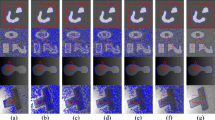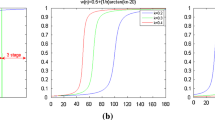Abstract
Image segmentation using local region-based active contour models can segment images with intensity inhomogeneity effectively, but their segmentation results are sensitive to the initialization and easy to get incorrect results when dealing with texture images. This paper presents a novel active contour model (ACM) for image segmentation. The proposed method adopts local kernel mapping to enhance the discriminative ability to delineate nonlinear decision boundaries between classes. In addition, we introduce a modified convex model and propose a fast evolving scheme accordingly to deal with the minimization of the model energy function. The proposed approach is validated by a comparative study over a large number of experiments on synthetic and real images. The experiments demonstrate that our method is more efficient and robust for segmenting different kinds of images compared with the state-of-the-art image segmentation methods.











Similar content being viewed by others
Explore related subjects
Discover the latest articles, news and stories from top researchers in related subjects.References
Osher S, Sethian JA (1988) Fronts propagating with curvature-dependent speed: algorithms based on Hamilton-Jacobi formulations. J Comput Phys 79(1):12–49
Ayed IB, Mitiche A, Belhadj Z (2005) Multiregion level-set partitioning of synthetic aperture radar images. IEEE Trans Pattern Anal Mach Intell 27(5):793–800
Ben Ayed I, Mitiche A, Belhadj Z (2006) Polarimetric image segmentation via maximum-likelihood approximation and efficient multiphase level-sets. IEEE Trans Pattern Anal Mach Intell 28(9):1493–1500
Ben Salah M, Mitiche A, Ben Ayed I (2010) Effective level set image segmentation with a kernel induced data term. IEEE Trans Image Process 19(1):220–232
Ayed IB, Mitiche A (2008) A region merging prior for variational level set image segmentation. IEEE Trans Image Process 17(12):2301–2311
Wang XF, Min H, Zou L et al (2015) A novel level set method for image segmentation by incorporating local statistical analysis and global similarity measurement. Pattern Recogn 48(1):189–204
Wang L, He L, Mishra A et al (2009) Active contours driven by local Gaussian distribution fitting energy. Sig Process 89(12):2435–2447
Malladi R, Sethian J, Vemuri BC (1995) Shape modeling with front propagation: a level set approach. IEEE Trans Pattern Anal Mach Intell 17(2):158–175
Li C, Xu C, Gui C et al (2005) Level set evolution without re-initialization: a new variational formulation. In: IEEE computer society conference on computer vision and pattern recognition, 2005. CVPR 2005. IEEE, 2005, vol 1, pp 430–436
Vasilevskiy A, Siddiqi K (2002) Flux maximizing geometric flows. IEEE Trans Pattern Anal Mach Intell 24(12):1565–1578
Yang X, Gao X, Li J et al (2014) A shape-initialized and intensity-adaptive level set method for auroral oval segmentation. Inf Sci 277:794–807
Wang Y, Xiang S, Pan C et al (2013) Level set evolution with locally linear classification for image segmentation. Pattern Recogn 46(6):1734–1746
Zhao YQ, Wang XH, Wang XF et al (2014) Retinal vessels segmentation based on level set and region growing. Pattern Recogn 47(7):2437–2446
Thapaliya K, Pyun JY, Park CS et al (2013) Level set method with automatic selective local statistics for brain tumor segmentation in MR images. Comput Med Imaging Graph 37(7):522–537
Wang XF, Min H, Zhang YG (2015) Multi-scale local region based level set method for image segmentation in the presence of intensity inhomogeneity. Neurocomputing 151:1086–1098
Wang L, Shi F, Li G et al (2014) Segmentation of neonatal brain MR images using patch-driven level sets. NeuroImage 84:141–158
Cote M, Saeedi P (2013) Automatic rooftop extraction in nadir aerial imagery of suburban regions using corners and variational level set evolution. IEEE Trans Geosci Remote Sens 51(1):313–328
Andersson T, Lathen G, Lenz R et al (2013) Modified gradient search for level set based image segmentation. IEEE Trans Image Process 22(2):621–630
Wang L, Pan C (2014) Robust level set image segmentation via a local correntropy-based K-means clustering. Pattern Recogn 47(5):1917–1925
Le T, Luu K, Savvides M (2013) SparCLeS: dynamic sparse classifiers with level sets for robust beard/moustache detection and segmentation. IEEE Trans Image Process 22(8):3097–3107
Hao M, Shi W, Zhang H et al (2014) Unsupervised change detection with expectation-maximization-based level set. IEEE Geosci Remote Sens Lett 11(1):210–214
Yang X, Gao X, Tao D et al (2015) An efficient MRF embedded level set method for image segmentation. IEEE Trans Image Process 24(1):9–21
Chan TF, Vese L (2001) Active contours without edges. IEEE Trans Image Process 10(2):266–277
Piovano J, Rousson M, Papadopoulo T (2007) Efficient segmentation of piecewise smooth images. In: Scale space and variational methods in computer vision. Springer, Berlin, Heidelberg, 2007, pp 709–720
Li C, Kao C Y, Gore JC et al (2007) Implicit active contours driven by local binary fitting energy. In: IEEE conference on computer vision and pattern recognition, 2007. CVPR’07. IEEE, pp 1–7
Wang L, He L, Mishra A et al (2009) Active contours driven by local Gaussian distribution fitting energy. Signal Process 89(12):2435–2447
Paragios N, Deriche R (2002) Geodesic active regions and level set methods for supervised texture segmentation]. Int J Comput Vis 46(3):223–247
Wang XF, Huang DS, Xu H (2010) An efficient local Chan–Vese model for image segmentation. Pattern Recogn 43(3):603–618
Sun K, Chen Z, Jiang S (2012) Local morphology fitting active contour for automatic vascular segmentation. IEEE Trans Biomed Eng 59(2):464–473
Zhang K, Song H, Zhang L (2010) Active contours driven by local image fitting energy. Pattern Recogn 43(4):1199–1206
Zhang J, Yu J, Tao D (2018) Local deep-feature alignment for unsupervised dimension reduction. IEEE Trans Image Process. https://doi.org/10.1109/TIP.2018.2804218
Yu J, Liu D, Tao D, Seah HS (2011) Complex object correspondence construction in 2D animation. IEEE Trans Image Process 20(11):3257–3269
Zhang K, Song H, Zhang L (2010) Active contours driven by local image fitting energy. Pattern Recogn 43(4):1199–1206
Zhang K, Zhang L, Lam KM et al (2015) A level set approach to image segmentation with intensity inhomogeneity. IEEE Trans Cybern 46(2):546–557
Goldstein T, Bresson X, Osher S (2010) Geometric applications of the split Bregman method: segmentation and surface reconstruction. J Sci Comput 45(1–3):272–293
Houhou N, Thiran J, Bresson X (2009) Fast texture segmentation based on semilocal region descriptor and active contour. Numer Math Theory Methods Appl 2(4):445–468
Müller KR, Mika S, Rätsch G et al (2001) An introduction to kernel-based learning algorithms. IEEE Trans Neural Netw 12(2):181–201
Dhillon IS, Guan Y, Kulis B (2007) Weighted graph cuts without eigenvectors a multilevel approach. IEEE Trans Pattern Anal Mach Intell 29(11):1944–1957
Wu KL, Yang MS (2002) Alternative c-means clustering algorithms. Pattern Recogn 35(10):2267–2278
Li C, Xu C, Gui C et al (2010) Distance regularized level set evolution and its application to image segmentation. IEEE Trans Image Process 19(12):3243–3254
Booth S, Clausi D (2001) Image segmentation using MRI vertebral cross-sections. In: Canadian conference on electrical and computer engineering, 2001. IEEE, 2001, vol 2, pp 1303–1307
Wang T, Ji Z, Sun Q, Chen Q, Han S (2015) Image segmentation based on weighting boundary information via graphcut. J Vis Commun Image Represent 33(c):10–19
Swain MJ, Ballard DH (1991) Color indexing. Int J Comput Vis 7:11–32
Unnikrishnan R, Pantofaru C, Hebert M (2005) A measure for objective evaluation of image segmentation algorithms. In: Proceedings of IEEE conference on computer vision and pattern recognition (CVPR), vol 3, pp 34–41
Olveresa J, Navaa R, Moya-Alborb E, Escalante-Ramírez B, Brievab J, Cristóbal G, Vallejo E (2014) Texture descriptor approaches to level set segmentation in medical images. In: Proceedings of SPIE 9138, optics, photonics, and digital technologies for multimedia applications, vol III, 91380 J (15 May 2014). http://dx.doi.org/10.1117/12.2054527
Martin D, Fowlkes C, Malik J (2004) Learning to detect natural image boundaries using local brightness, color, and texture cues. IEEE Trans Pattern Anal Mach Intell 26:530–549
Peng B, Zhang L (2012) Evaluation of image segmentation quality by adaptive ground truth composition. In: 12th European conference on computer vision (ECCV). Lecture notes in computer science, vol 7574, pp 287–300
Liu W, Zhang H, Tao D, Wang Y, Lu K (2013) Large-scale paralleled sparse principal component analysis. Multimedia Tools Appl 75(3):1–13
Acknowledgements
This work has been partially supported by National Science Foundation of China (6100318, 61371168), National High Technology Research and Development Program of China (No. 2013AA014604), National key research and development program of China (2016YFC0801304, 2017YFC0803705), Jiangsu Province Regular Institutions of Higher Learning Academic Degree Graduate Student Innovation Plan (KYZZ16_0192).
Author information
Authors and Affiliations
Corresponding author
Rights and permissions
About this article
Cite this article
Li, Y., Cao, G., Yu, Q. et al. Fast and Robust Active Contours Model for Image Segmentation. Neural Process Lett 49, 431–452 (2019). https://doi.org/10.1007/s11063-018-9827-3
Published:
Issue Date:
DOI: https://doi.org/10.1007/s11063-018-9827-3




